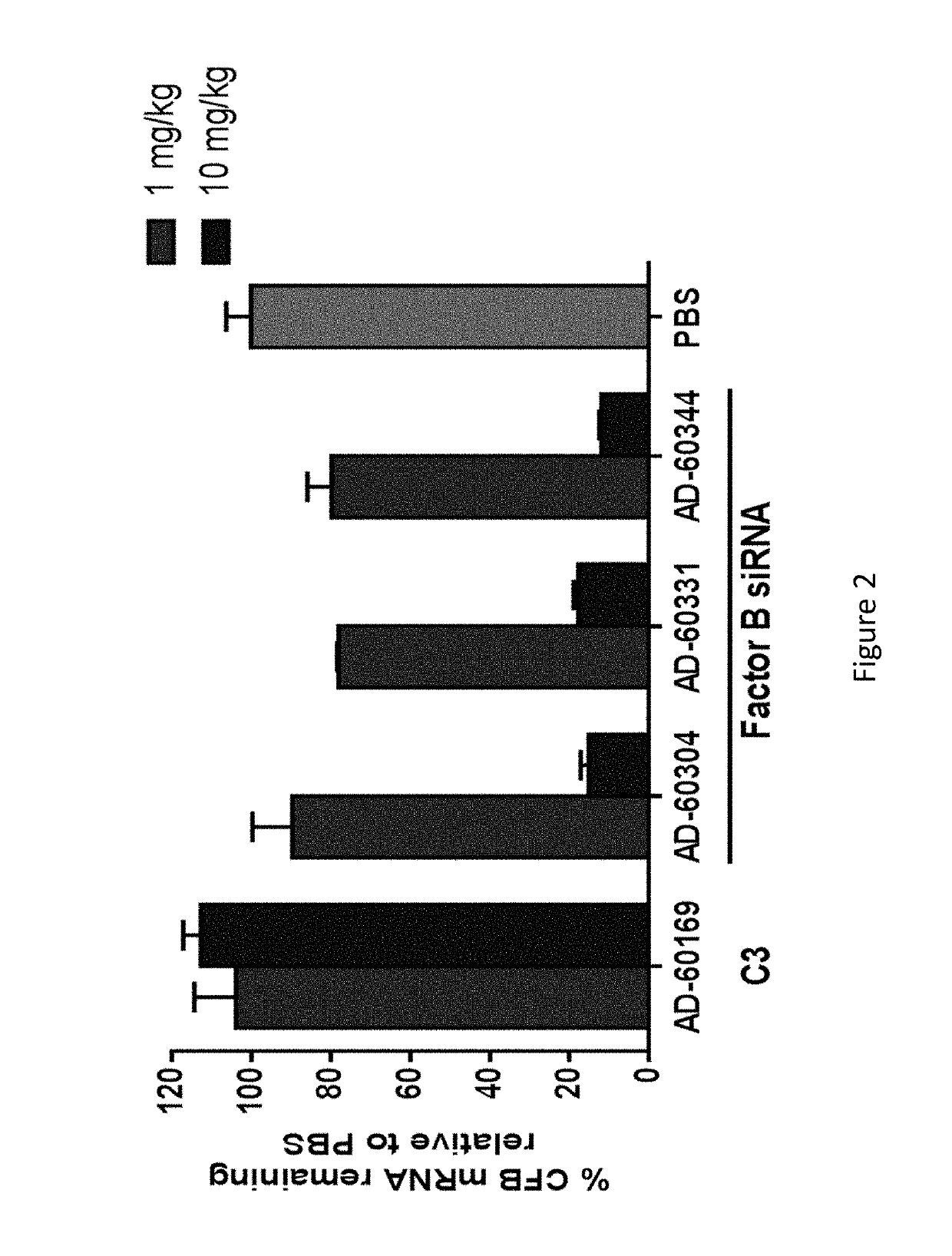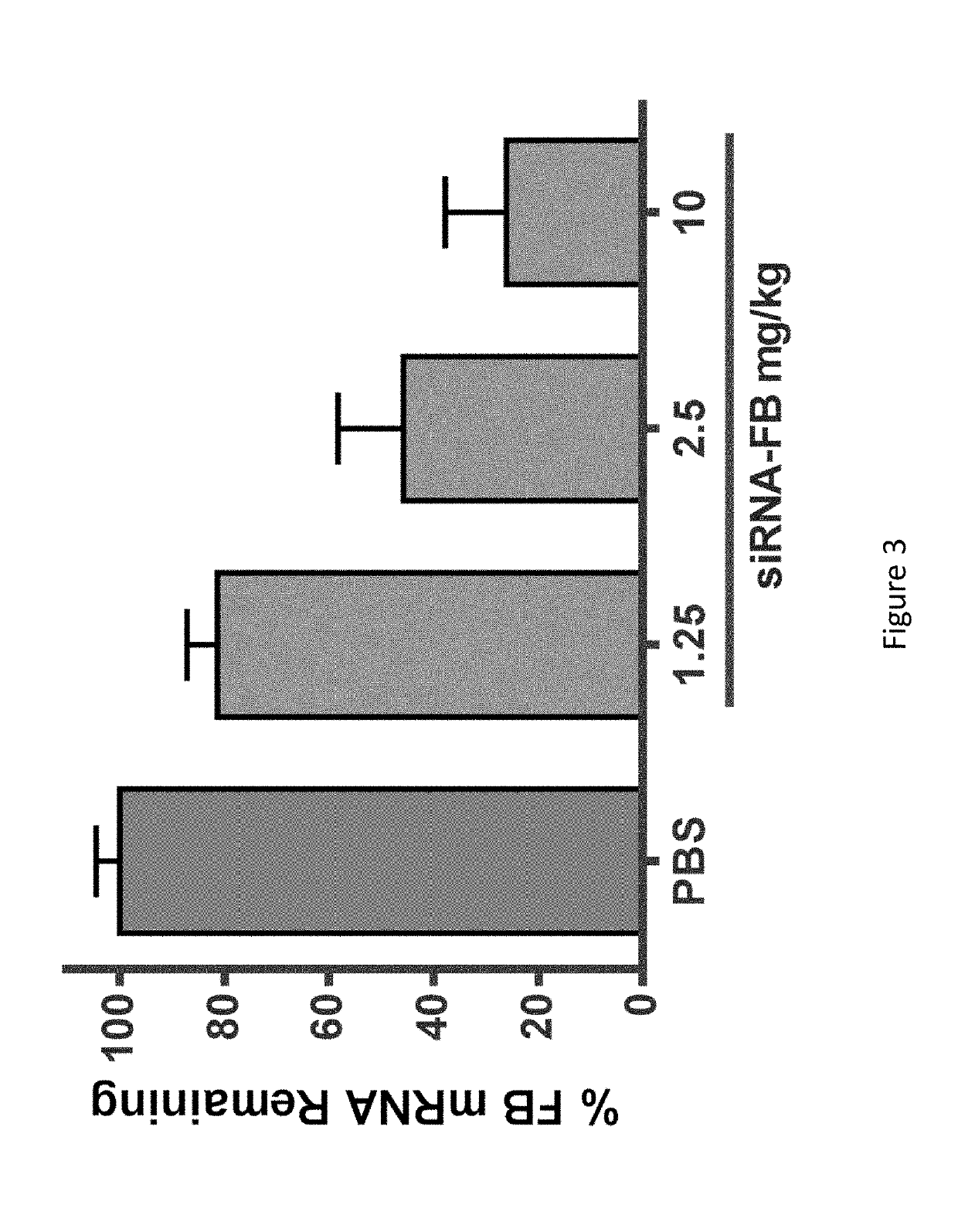Complement component iRNA compositions and methods of use thereof
a technology of irna composition and component, which is applied in the field of complement component irna composition, can solve the problems of high cost of eculizumab therapy, weekly high dose infusion followed by biweekly maintenance infusion
- Summary
- Abstract
- Description
- Claims
- Application Information
AI Technical Summary
Benefits of technology
Problems solved by technology
Method used
Image
Examples
example 1
hesis
Source of Reagents
[0893]Where the source of a reagent is not specifically given herein, such reagent can be obtained from any supplier of reagents for molecular biology at a quality / purity standard for application in molecular biology.
Transcripts
[0894]siRNA design was carried out to identify siRNAs targeting human (Homo sapiens), cynomolgus monkey (Macaca fascicularis; henceforth “cyno”), mouse (Mus musculus), and rat (Rattus norvegicus) transcripts. In general, the design of duplexes used human, mouse, and rat transcripts from the NCBI RefSeq collection, annotated in the NCBI Gene database (http: / / www.ncbi.nlm.nih.gov / gene / ). For cyno, the design used either transcripts downloaded from the M. fascicularis genome project (http: / / macaque.genomics.org.cn / page / species / download.jsp) and / or transcripts obtained from a liver-derived cDNA library.
[0895]Design of CFB siRNAs used the following transcripts from the NCBI RefSeq collection: Human—NM_001710; Cyno (from the M. fascicularis g...
example 2
Screening
Cell Culture and Transfections
[0923]Hep3B cells (ATCC, Manassas, Va.) were grown to near confluence at 37° C. in an atmosphere of 5% CO2 in Eagle's Minimum Essential Medium (ATCC) supplemented with 10% FBS, streptomycin, and glutamine (ATCC) before being released from the plate by trypsinization. Cells were washed and re-suspended at 0.25×106 cells / ml. During transfections, cells were plated onto a 96-well plate with about 20,000 cells per well.
[0924]Primary mouse hepatocytes (PMH) were freshly isolated from a C57BL / 6 female mouse (Charles River Labortories International, Inc. Willmington, Mass.) less than 1 hour prior to transfections and grown in primary hepatocyte media. Cells were resuspended at 0.11×106 cells / ml in InVitroGRO CP Rat (plating) medium (Celsis In Vitro Technologies, catalog number S01494). During transfections, cells were plated onto a BD BioCoat 96 well collagen plate (BD, 356407) at 10,000 cells per well and incubated at 37° C. in an atmosphere of 5% CO...
example 3
creening
[0958]A subset of three CFB GalNAC conjugated iRNAs was selected for further in vivo evaluation, AD-60304, AD-60331, and AD-60344. The nucleotide sequences of the sense and antisens strands of these iRNA agents are provided in Table 18. As indicated in Table 19, the nucleotide sequence of AD-60304 is a perfect match to the mouse and rat nucleotide sequences. The nucleotide sequence of AD-60331 and the nucleotide sequence of AD-60344 have nucleotide mismatches (“MM”; see bolded, underlined nucleotides) to the mouse gene but have activity in mouse hepatocytes.
[0959]C57BL / 6 mice (N=3 per group) were injected subcutaneously with either 1 mg / kg or 10 mg / kg of GalNAc conjugated duplexes or an equal volume of 1× Dulbecco's Phosphate-Buffered Saline (DPBS) (Life Technologies, Cat#14040133). Ninety-six hours later, mice were euthanized and the livers were dissected and flash frozen in liquid nitrogen. Livers were ground in a 2000 Geno / Grinder (SPEX SamplePrep, Metuchen, N.J.). Approx...
PUM
 Login to View More
Login to View More Abstract
Description
Claims
Application Information
 Login to View More
Login to View More - R&D
- Intellectual Property
- Life Sciences
- Materials
- Tech Scout
- Unparalleled Data Quality
- Higher Quality Content
- 60% Fewer Hallucinations
Browse by: Latest US Patents, China's latest patents, Technical Efficacy Thesaurus, Application Domain, Technology Topic, Popular Technical Reports.
© 2025 PatSnap. All rights reserved.Legal|Privacy policy|Modern Slavery Act Transparency Statement|Sitemap|About US| Contact US: help@patsnap.com



